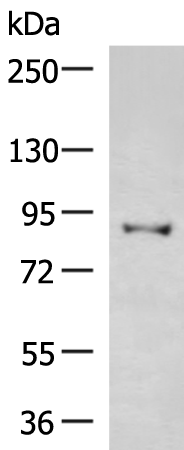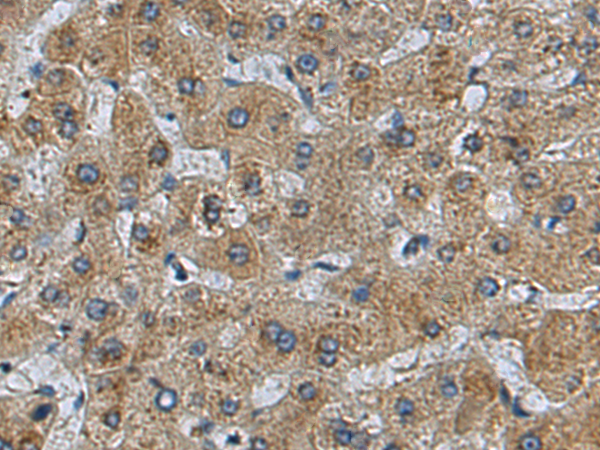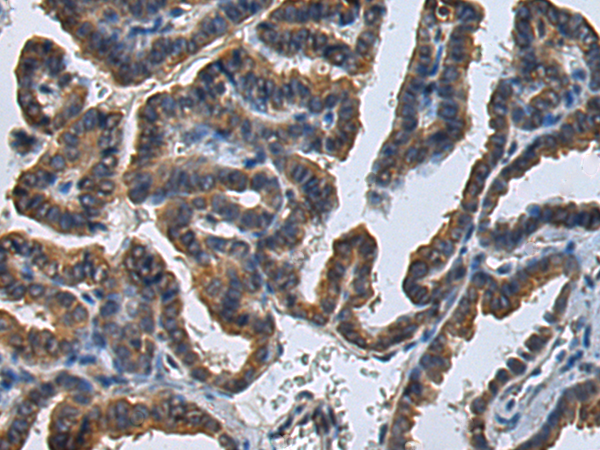


| WB | 咨询技术 | Human,Mouse,Rat |
| IF | 咨询技术 | Human,Mouse,Rat |
| IHC | 1/100-1/300 | Human,Mouse,Rat |
| ICC | 技术咨询 | Human,Mouse,Rat |
| FCM | 咨询技术 | Human,Mouse,Rat |
| Elisa | 1/5000-1/10000 | Human,Mouse,Rat |
| Aliases | SR3; DFCP1; TAFF1; ZNFN2A1; PPP1R172 |
| WB Predicted band size | 87 kDa |
| Host/Isotype | Rabbit IgG |
| Antibody Type | Primary antibody |
| Storage | Store at 4°C short term. Aliquot and store at -20°C long term. Avoid freeze/thaw cycles. |
| Species Reactivity | Human, Mouse |
| Immunogen | Fusion protein of human ZFYVE1 |
| Formulation | Purified antibody in PBS with 0.05% sodium azide and 50% glycerol. |
+ +
以下是3篇涉及ZFYVE1(SARA)抗体的文献及其摘要概括:
---
1. **文献名称**:*SARA, a FYVE Domain Protein Required for TGF-β Signaling*
**作者**:Tsukazaki T, et al.
**摘要**:该研究首次鉴定了SARA蛋白(即ZFYVE1),其通过FYVE结构域锚定于内体膜,并作为TGF-β信号通路的支架蛋白。研究中使用特异性SARA抗体验证其在内体中的定位,并证明其通过招募Smad2/3促进TGF-β受体信号传递。
---
2. **文献名称**:*Endocytic Regulation of TGF-β Signaling by SARA/ Smad2*
**作者**:Penheiter SG, et al.
**摘要**:本文通过免疫沉淀和免疫荧光技术,利用抗SARA抗体揭示了SARA蛋白在介导Smad2与TGF-β受体结合中的关键作用,并发现SARA的磷酸化状态影响其在信号转导中的功能。
---
3. **文献名称**:*Distinct Endocytic Pathways Regulate TGF-β Receptor Signaling*
**作者**:Di Guglielmo GM, et al.
**摘要**:研究探讨了SARA依赖的TGF-β信号内体转运机制。通过SARA抗体的Western blot和共聚焦显微镜分析,证实了SARA在内体区室中调控受体-Smad复合物的形成及信号特异性。
---
**备注**:ZFYVE1抗体相关文献较少,以上研究聚焦于其功能机制,并依赖抗体进行蛋白定位与互作验证。建议通过PubMed或抗体供应商(如Abcam、Santa Cruz)的产品引用列表获取更多技术文献。
ZFYVE1 antibody is a research tool targeting the ZFYVE1 protein, encoded by the ZFYVE1 gene (zinc finger FYVE-type containing 1), also known as DFCP1 (Double FYVE-containing protein 1). ZFYVE1 is a membrane-associated protein involved in intracellular vesicle trafficking, autophagy, and endosomal dynamics. It contains a FYVE domain, which binds phosphatidylinositol 3-phosphate (PI3P), enabling its localization to membranes of the endoplasmic reticulum (ER), Golgi apparatus, and omegasomes—transient structures critical for autophagosome formation.
The ZFYVE1 protein plays a regulatory role in autophagy by interacting with autophagy-related proteins like ULK1 and WIPI2. facilitating membrane remodeling during autophagosome biogenesis. It is also implicated in maintaining ER morphology and lipid droplet dynamics. Antibodies against ZFYVE1 are widely used in immunoblotting (WB), immunofluorescence (IF), and immunoprecipitation (IP) to study its expression, subcellular localization, and molecular interactions.
Research utilizing ZFYVE1 antibodies has provided insights into diseases linked to autophagy dysregulation, including neurodegenerative disorders, cancer, and metabolic syndromes. Variations in ZFYVE1 expression or function have been observed in certain cancers, suggesting potential roles in tumor progression or suppression. Commercial ZFYVE1 antibodies are typically validated for specificity across human, mouse, and rat samples, with applications spanning basic cell biology and translational studies. Proper controls, such as knockout cell lines, are recommended to confirm antibody specificity in experimental settings.
×